Decision Making Analysis: Suzuki's Office Location and SMART Technique
VerifiedAdded on 2020/05/16
|22
|5012
|164
Report
AI Summary
This report delves into the concept of decision-making, emphasizing its critical role in business organizations. It defines decision-making as a process of selecting the best alternative to guide an organization's path and ensure its credibility. The report explores various decision-making tools and criteria. A central component of the report is a case study involving Suzuki, an automobile company, and its office location decisions. The Simple Multi-Variable Rating Technique (SMART) is employed to analyze this decision problem, offering insights into the strengths and limitations of the SMART analysis. The report concludes with a summary of the findings, highlighting the importance of informed decision-making in achieving organizational goals and the practical application of analytical tools in real-world scenarios.
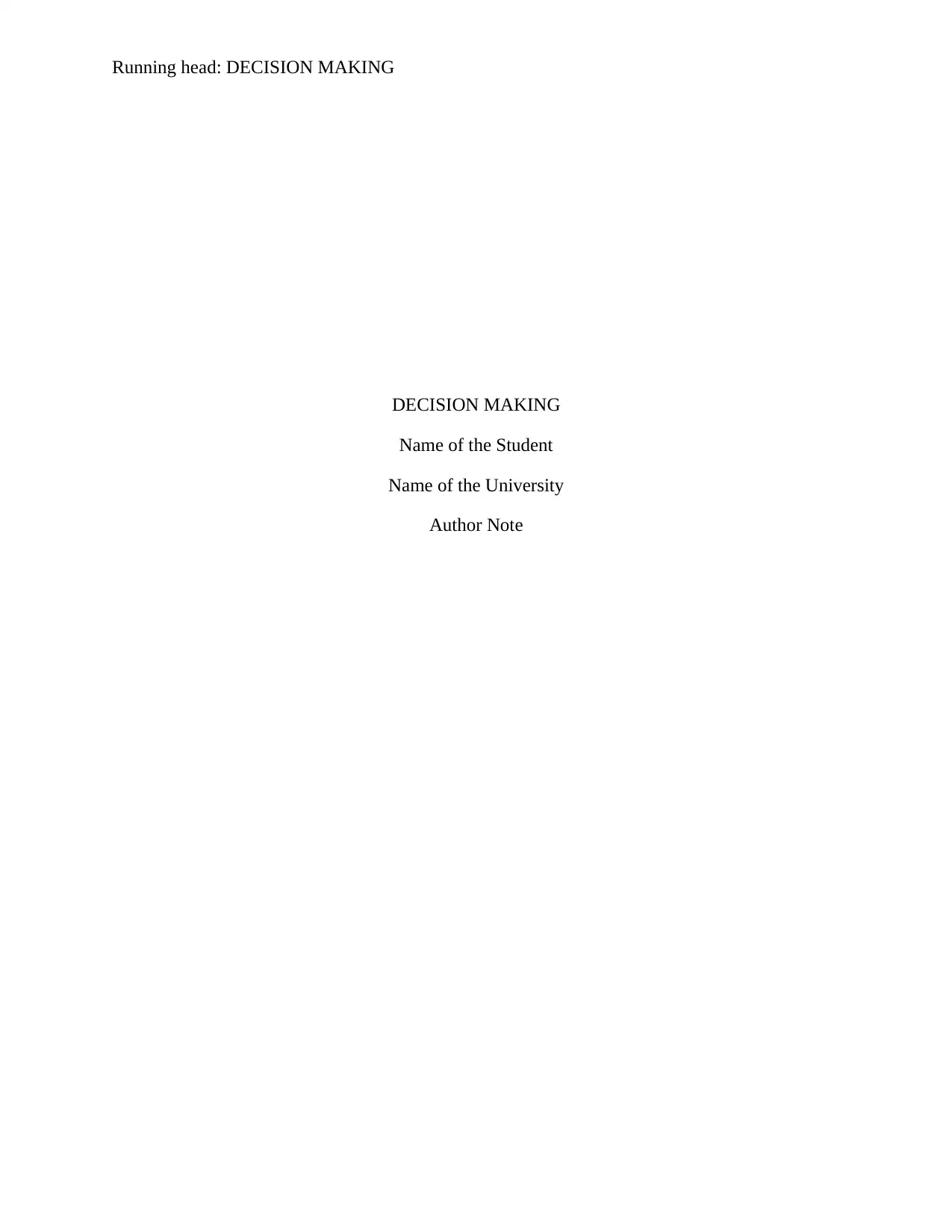
Running head: DECISION MAKING
DECISION MAKING
Name of the Student
Name of the University
Author Note
DECISION MAKING
Name of the Student
Name of the University
Author Note
Paraphrase This Document
Need a fresh take? Get an instant paraphrase of this document with our AI Paraphraser
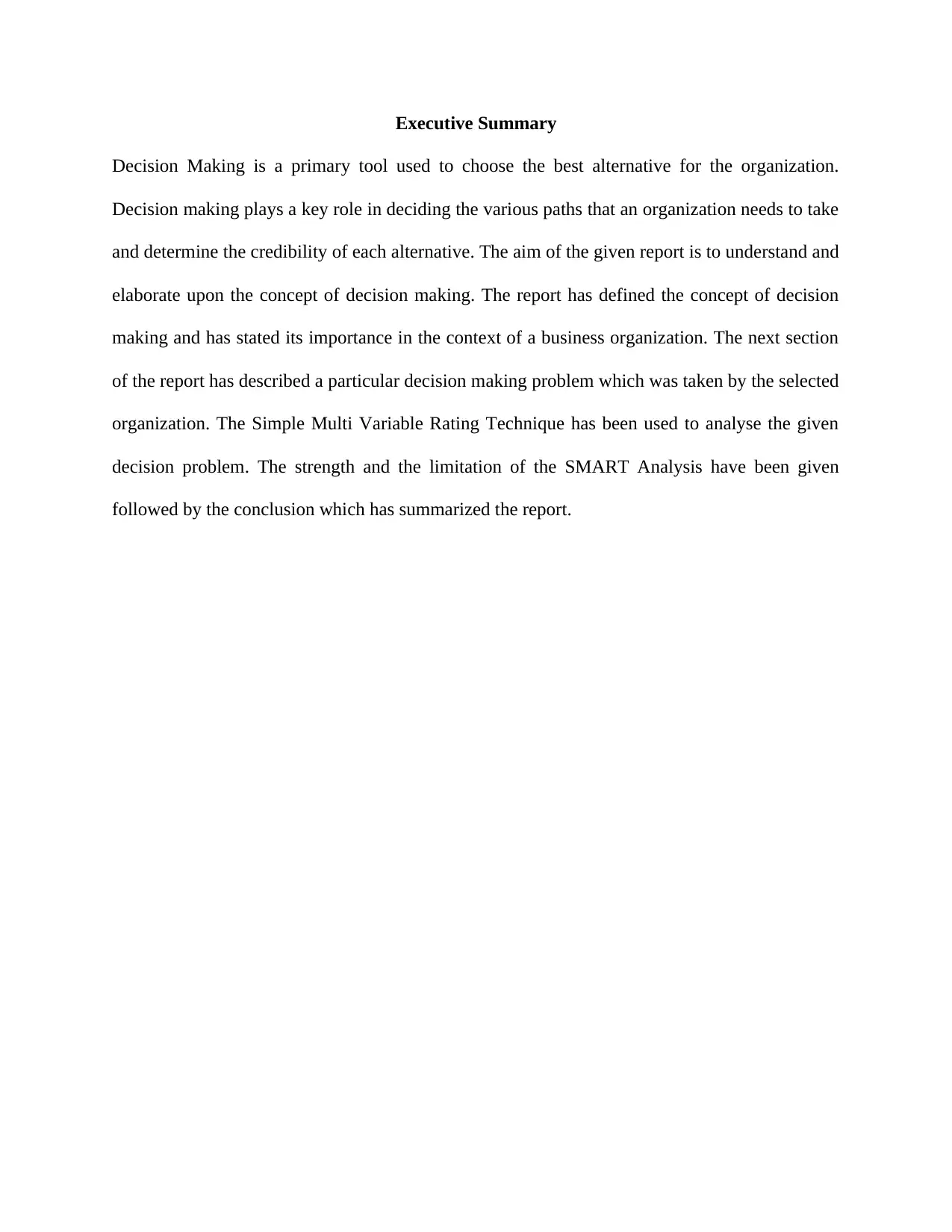
Executive Summary
Decision Making is a primary tool used to choose the best alternative for the organization.
Decision making plays a key role in deciding the various paths that an organization needs to take
and determine the credibility of each alternative. The aim of the given report is to understand and
elaborate upon the concept of decision making. The report has defined the concept of decision
making and has stated its importance in the context of a business organization. The next section
of the report has described a particular decision making problem which was taken by the selected
organization. The Simple Multi Variable Rating Technique has been used to analyse the given
decision problem. The strength and the limitation of the SMART Analysis have been given
followed by the conclusion which has summarized the report.
Decision Making is a primary tool used to choose the best alternative for the organization.
Decision making plays a key role in deciding the various paths that an organization needs to take
and determine the credibility of each alternative. The aim of the given report is to understand and
elaborate upon the concept of decision making. The report has defined the concept of decision
making and has stated its importance in the context of a business organization. The next section
of the report has described a particular decision making problem which was taken by the selected
organization. The Simple Multi Variable Rating Technique has been used to analyse the given
decision problem. The strength and the limitation of the SMART Analysis have been given
followed by the conclusion which has summarized the report.
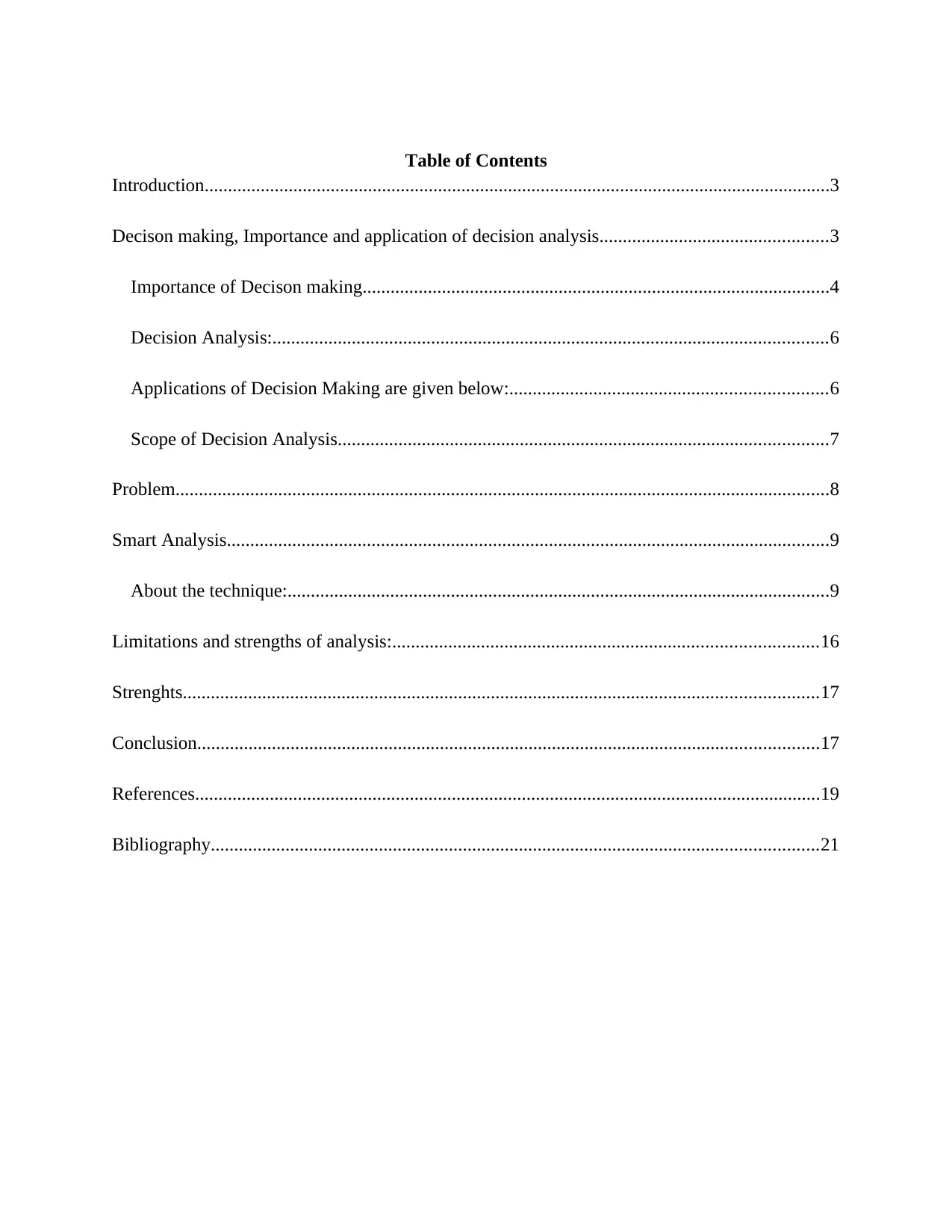
Table of Contents
Introduction......................................................................................................................................3
Decison making, Importance and application of decision analysis.................................................3
Importance of Decison making....................................................................................................4
Decision Analysis:.......................................................................................................................6
Applications of Decision Making are given below:....................................................................6
Scope of Decision Analysis.........................................................................................................7
Problem............................................................................................................................................8
Smart Analysis.................................................................................................................................9
About the technique:....................................................................................................................9
Limitations and strengths of analysis:...........................................................................................16
Strenghts........................................................................................................................................17
Conclusion.....................................................................................................................................17
References......................................................................................................................................19
Bibliography..................................................................................................................................21
Introduction......................................................................................................................................3
Decison making, Importance and application of decision analysis.................................................3
Importance of Decison making....................................................................................................4
Decision Analysis:.......................................................................................................................6
Applications of Decision Making are given below:....................................................................6
Scope of Decision Analysis.........................................................................................................7
Problem............................................................................................................................................8
Smart Analysis.................................................................................................................................9
About the technique:....................................................................................................................9
Limitations and strengths of analysis:...........................................................................................16
Strenghts........................................................................................................................................17
Conclusion.....................................................................................................................................17
References......................................................................................................................................19
Bibliography..................................................................................................................................21
⊘ This is a preview!⊘
Do you want full access?
Subscribe today to unlock all pages.

Trusted by 1+ million students worldwide
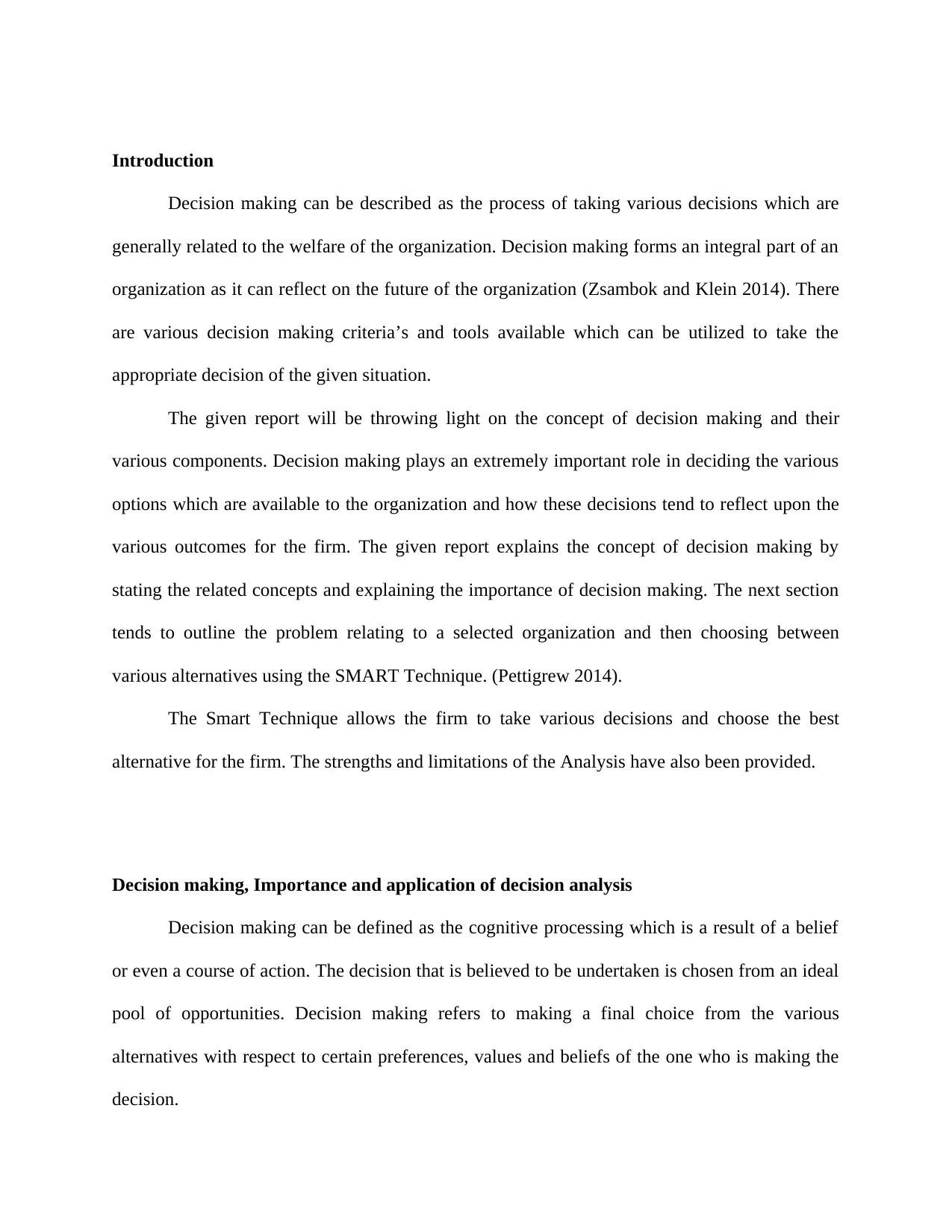
Introduction
Decision making can be described as the process of taking various decisions which are
generally related to the welfare of the organization. Decision making forms an integral part of an
organization as it can reflect on the future of the organization (Zsambok and Klein 2014). There
are various decision making criteria’s and tools available which can be utilized to take the
appropriate decision of the given situation.
The given report will be throwing light on the concept of decision making and their
various components. Decision making plays an extremely important role in deciding the various
options which are available to the organization and how these decisions tend to reflect upon the
various outcomes for the firm. The given report explains the concept of decision making by
stating the related concepts and explaining the importance of decision making. The next section
tends to outline the problem relating to a selected organization and then choosing between
various alternatives using the SMART Technique. (Pettigrew 2014).
The Smart Technique allows the firm to take various decisions and choose the best
alternative for the firm. The strengths and limitations of the Analysis have also been provided.
Decision making, Importance and application of decision analysis
Decision making can be defined as the cognitive processing which is a result of a belief
or even a course of action. The decision that is believed to be undertaken is chosen from an ideal
pool of opportunities. Decision making refers to making a final choice from the various
alternatives with respect to certain preferences, values and beliefs of the one who is making the
decision.
Decision making can be described as the process of taking various decisions which are
generally related to the welfare of the organization. Decision making forms an integral part of an
organization as it can reflect on the future of the organization (Zsambok and Klein 2014). There
are various decision making criteria’s and tools available which can be utilized to take the
appropriate decision of the given situation.
The given report will be throwing light on the concept of decision making and their
various components. Decision making plays an extremely important role in deciding the various
options which are available to the organization and how these decisions tend to reflect upon the
various outcomes for the firm. The given report explains the concept of decision making by
stating the related concepts and explaining the importance of decision making. The next section
tends to outline the problem relating to a selected organization and then choosing between
various alternatives using the SMART Technique. (Pettigrew 2014).
The Smart Technique allows the firm to take various decisions and choose the best
alternative for the firm. The strengths and limitations of the Analysis have also been provided.
Decision making, Importance and application of decision analysis
Decision making can be defined as the cognitive processing which is a result of a belief
or even a course of action. The decision that is believed to be undertaken is chosen from an ideal
pool of opportunities. Decision making refers to making a final choice from the various
alternatives with respect to certain preferences, values and beliefs of the one who is making the
decision.
Paraphrase This Document
Need a fresh take? Get an instant paraphrase of this document with our AI Paraphraser
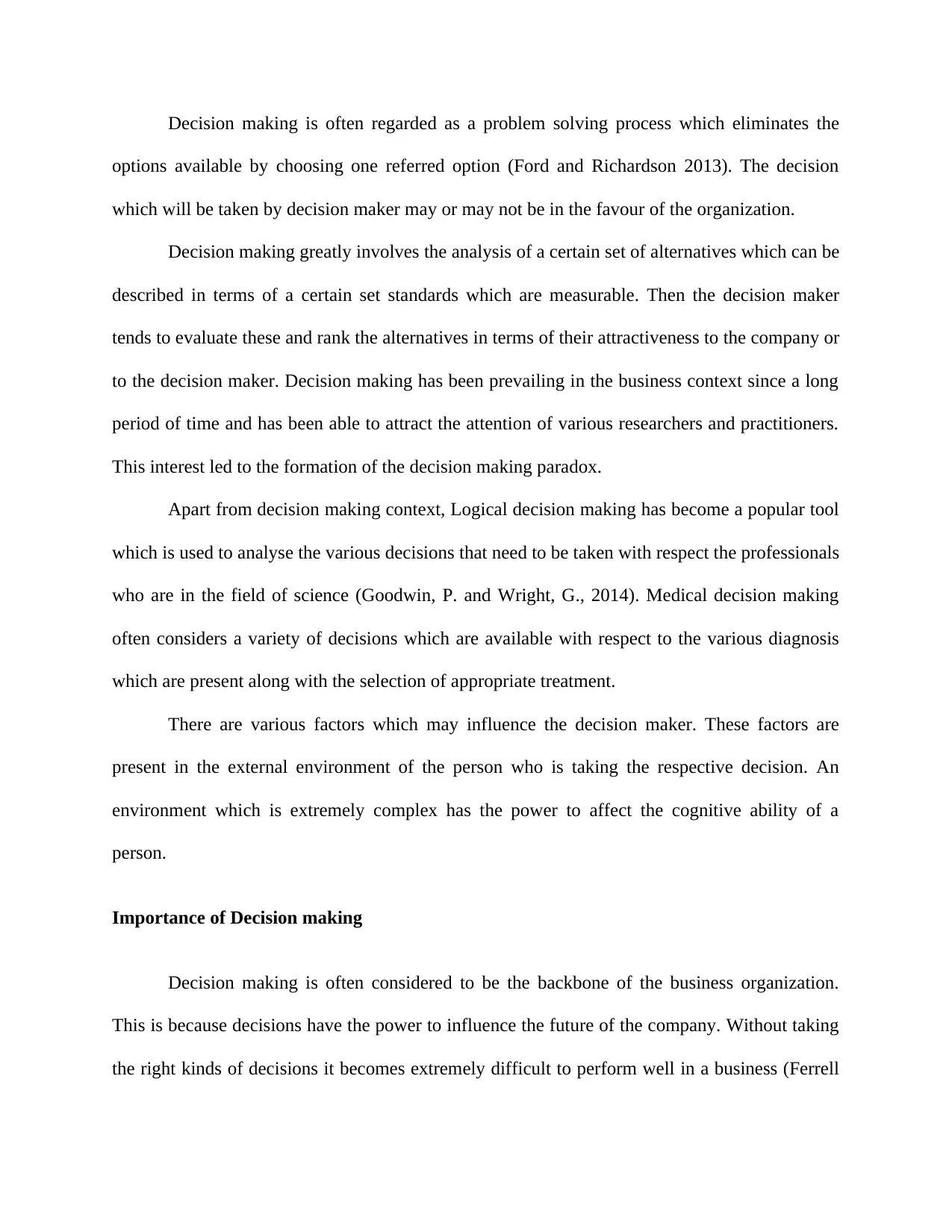
Decision making is often regarded as a problem solving process which eliminates the
options available by choosing one referred option (Ford and Richardson 2013). The decision
which will be taken by decision maker may or may not be in the favour of the organization.
Decision making greatly involves the analysis of a certain set of alternatives which can be
described in terms of a certain set standards which are measurable. Then the decision maker
tends to evaluate these and rank the alternatives in terms of their attractiveness to the company or
to the decision maker. Decision making has been prevailing in the business context since a long
period of time and has been able to attract the attention of various researchers and practitioners.
This interest led to the formation of the decision making paradox.
Apart from decision making context, Logical decision making has become a popular tool
which is used to analyse the various decisions that need to be taken with respect the professionals
who are in the field of science (Goodwin, P. and Wright, G., 2014). Medical decision making
often considers a variety of decisions which are available with respect to the various diagnosis
which are present along with the selection of appropriate treatment.
There are various factors which may influence the decision maker. These factors are
present in the external environment of the person who is taking the respective decision. An
environment which is extremely complex has the power to affect the cognitive ability of a
person.
Importance of Decision making
Decision making is often considered to be the backbone of the business organization.
This is because decisions have the power to influence the future of the company. Without taking
the right kinds of decisions it becomes extremely difficult to perform well in a business (Ferrell
options available by choosing one referred option (Ford and Richardson 2013). The decision
which will be taken by decision maker may or may not be in the favour of the organization.
Decision making greatly involves the analysis of a certain set of alternatives which can be
described in terms of a certain set standards which are measurable. Then the decision maker
tends to evaluate these and rank the alternatives in terms of their attractiveness to the company or
to the decision maker. Decision making has been prevailing in the business context since a long
period of time and has been able to attract the attention of various researchers and practitioners.
This interest led to the formation of the decision making paradox.
Apart from decision making context, Logical decision making has become a popular tool
which is used to analyse the various decisions that need to be taken with respect the professionals
who are in the field of science (Goodwin, P. and Wright, G., 2014). Medical decision making
often considers a variety of decisions which are available with respect to the various diagnosis
which are present along with the selection of appropriate treatment.
There are various factors which may influence the decision maker. These factors are
present in the external environment of the person who is taking the respective decision. An
environment which is extremely complex has the power to affect the cognitive ability of a
person.
Importance of Decision making
Decision making is often considered to be the backbone of the business organization.
This is because decisions have the power to influence the future of the company. Without taking
the right kinds of decisions it becomes extremely difficult to perform well in a business (Ferrell
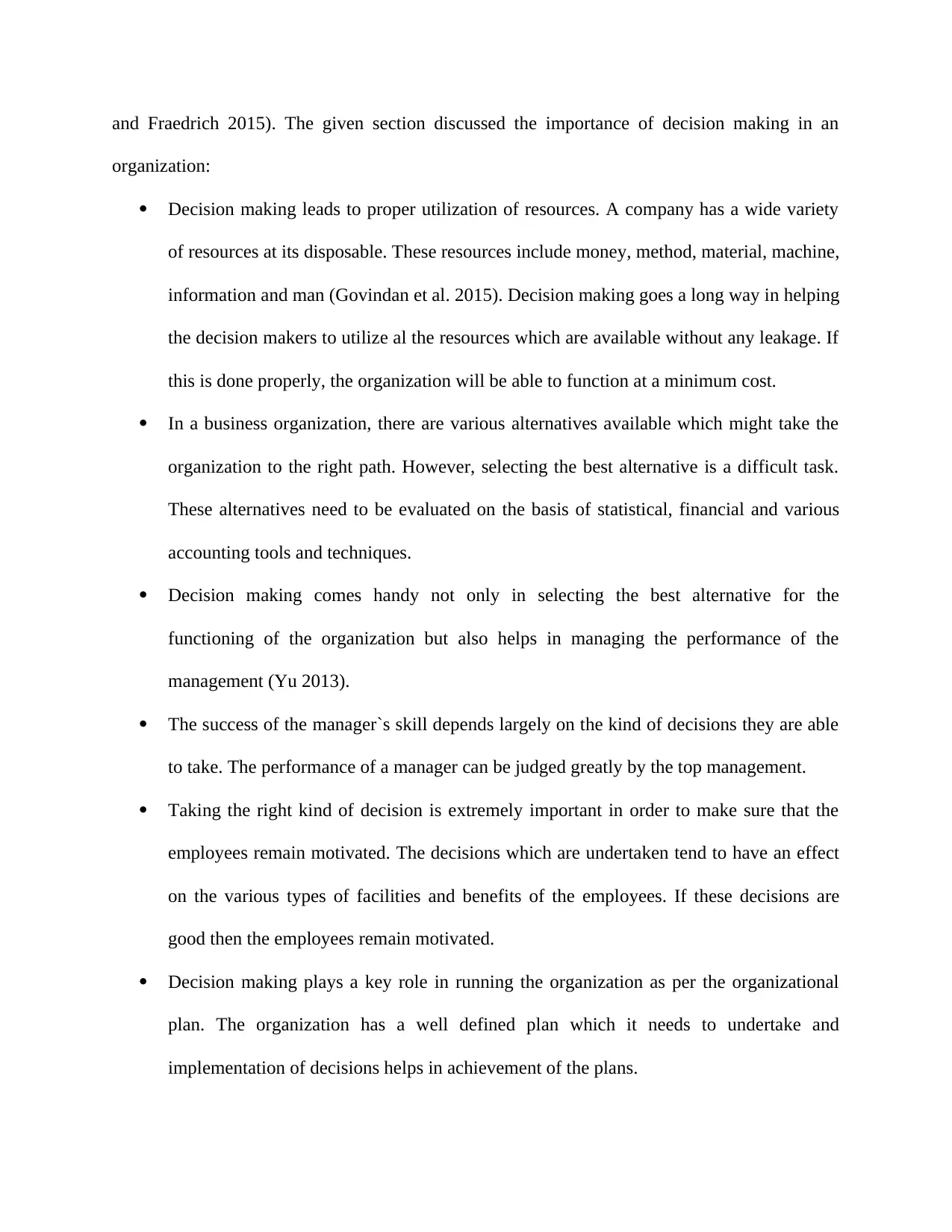
and Fraedrich 2015). The given section discussed the importance of decision making in an
organization:
Decision making leads to proper utilization of resources. A company has a wide variety
of resources at its disposable. These resources include money, method, material, machine,
information and man (Govindan et al. 2015). Decision making goes a long way in helping
the decision makers to utilize al the resources which are available without any leakage. If
this is done properly, the organization will be able to function at a minimum cost.
In a business organization, there are various alternatives available which might take the
organization to the right path. However, selecting the best alternative is a difficult task.
These alternatives need to be evaluated on the basis of statistical, financial and various
accounting tools and techniques.
Decision making comes handy not only in selecting the best alternative for the
functioning of the organization but also helps in managing the performance of the
management (Yu 2013).
The success of the manager`s skill depends largely on the kind of decisions they are able
to take. The performance of a manager can be judged greatly by the top management.
Taking the right kind of decision is extremely important in order to make sure that the
employees remain motivated. The decisions which are undertaken tend to have an effect
on the various types of facilities and benefits of the employees. If these decisions are
good then the employees remain motivated.
Decision making plays a key role in running the organization as per the organizational
plan. The organization has a well defined plan which it needs to undertake and
implementation of decisions helps in achievement of the plans.
organization:
Decision making leads to proper utilization of resources. A company has a wide variety
of resources at its disposable. These resources include money, method, material, machine,
information and man (Govindan et al. 2015). Decision making goes a long way in helping
the decision makers to utilize al the resources which are available without any leakage. If
this is done properly, the organization will be able to function at a minimum cost.
In a business organization, there are various alternatives available which might take the
organization to the right path. However, selecting the best alternative is a difficult task.
These alternatives need to be evaluated on the basis of statistical, financial and various
accounting tools and techniques.
Decision making comes handy not only in selecting the best alternative for the
functioning of the organization but also helps in managing the performance of the
management (Yu 2013).
The success of the manager`s skill depends largely on the kind of decisions they are able
to take. The performance of a manager can be judged greatly by the top management.
Taking the right kind of decision is extremely important in order to make sure that the
employees remain motivated. The decisions which are undertaken tend to have an effect
on the various types of facilities and benefits of the employees. If these decisions are
good then the employees remain motivated.
Decision making plays a key role in running the organization as per the organizational
plan. The organization has a well defined plan which it needs to undertake and
implementation of decisions helps in achievement of the plans.
⊘ This is a preview!⊘
Do you want full access?
Subscribe today to unlock all pages.

Trusted by 1+ million students worldwide
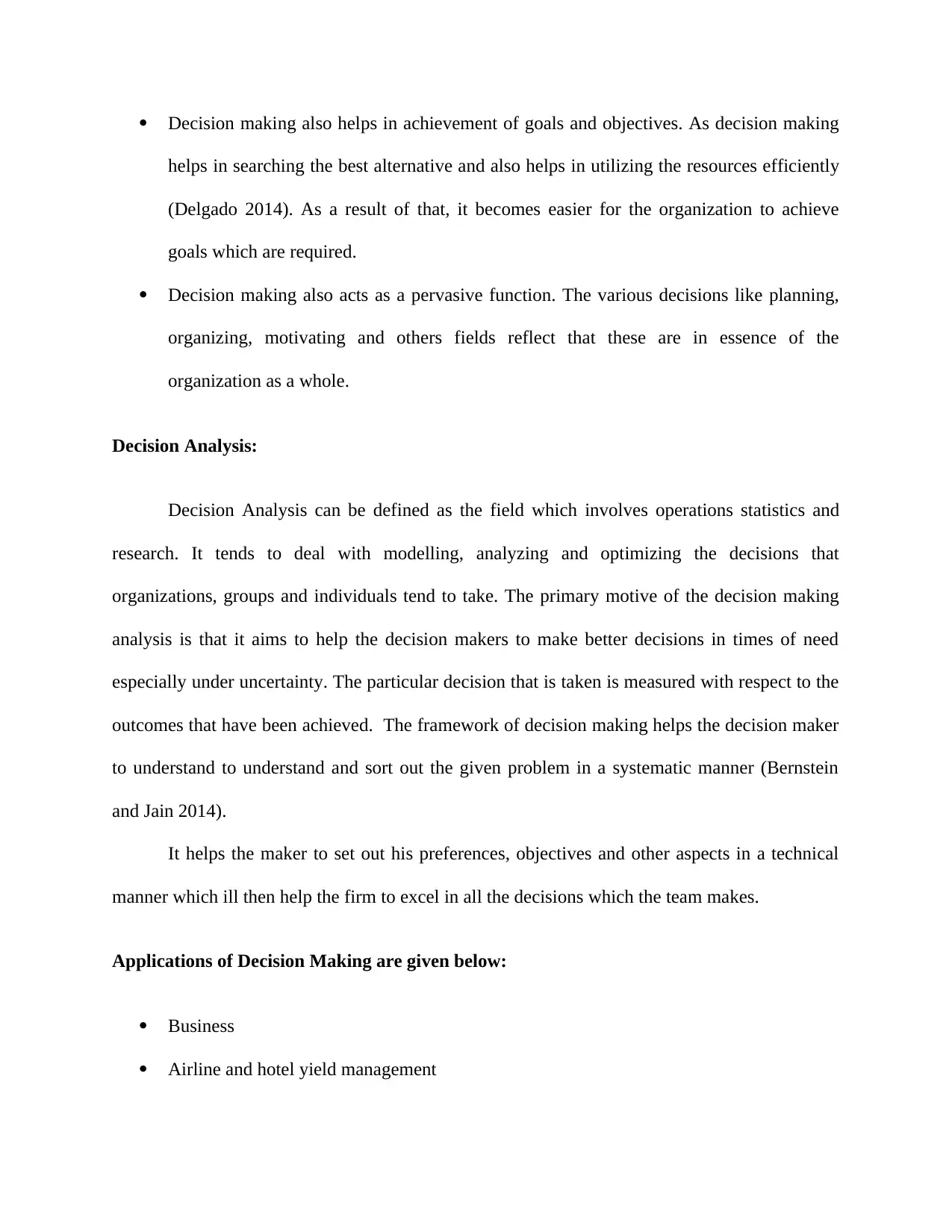
Decision making also helps in achievement of goals and objectives. As decision making
helps in searching the best alternative and also helps in utilizing the resources efficiently
(Delgado 2014). As a result of that, it becomes easier for the organization to achieve
goals which are required.
Decision making also acts as a pervasive function. The various decisions like planning,
organizing, motivating and others fields reflect that these are in essence of the
organization as a whole.
Decision Analysis:
Decision Analysis can be defined as the field which involves operations statistics and
research. It tends to deal with modelling, analyzing and optimizing the decisions that
organizations, groups and individuals tend to take. The primary motive of the decision making
analysis is that it aims to help the decision makers to make better decisions in times of need
especially under uncertainty. The particular decision that is taken is measured with respect to the
outcomes that have been achieved. The framework of decision making helps the decision maker
to understand to understand and sort out the given problem in a systematic manner (Bernstein
and Jain 2014).
It helps the maker to set out his preferences, objectives and other aspects in a technical
manner which ill then help the firm to excel in all the decisions which the team makes.
Applications of Decision Making are given below:
Business
Airline and hotel yield management
helps in searching the best alternative and also helps in utilizing the resources efficiently
(Delgado 2014). As a result of that, it becomes easier for the organization to achieve
goals which are required.
Decision making also acts as a pervasive function. The various decisions like planning,
organizing, motivating and others fields reflect that these are in essence of the
organization as a whole.
Decision Analysis:
Decision Analysis can be defined as the field which involves operations statistics and
research. It tends to deal with modelling, analyzing and optimizing the decisions that
organizations, groups and individuals tend to take. The primary motive of the decision making
analysis is that it aims to help the decision makers to make better decisions in times of need
especially under uncertainty. The particular decision that is taken is measured with respect to the
outcomes that have been achieved. The framework of decision making helps the decision maker
to understand to understand and sort out the given problem in a systematic manner (Bernstein
and Jain 2014).
It helps the maker to set out his preferences, objectives and other aspects in a technical
manner which ill then help the firm to excel in all the decisions which the team makes.
Applications of Decision Making are given below:
Business
Airline and hotel yield management
Paraphrase This Document
Need a fresh take? Get an instant paraphrase of this document with our AI Paraphraser
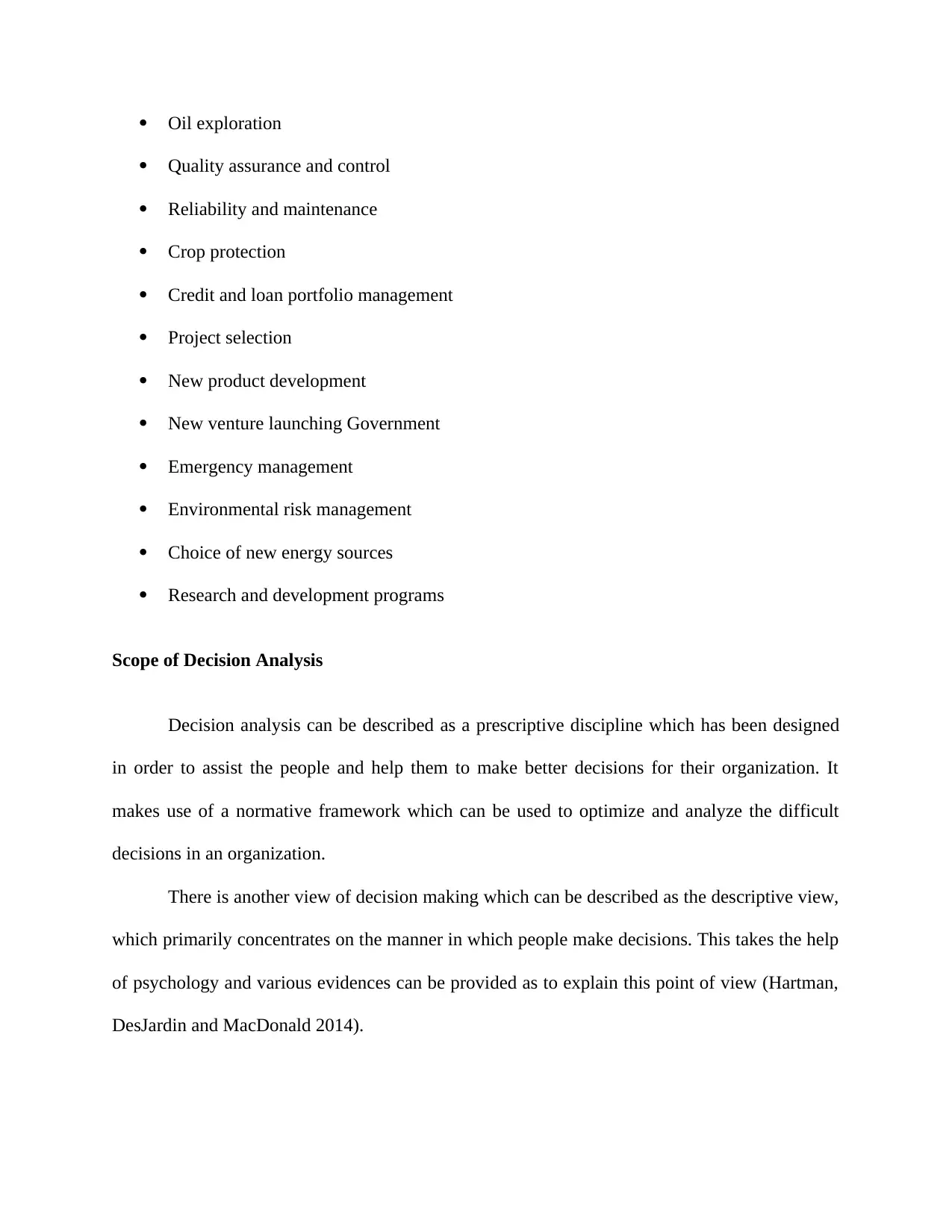
Oil exploration
Quality assurance and control
Reliability and maintenance
Crop protection
Credit and loan portfolio management
Project selection
New product development
New venture launching Government
Emergency management
Environmental risk management
Choice of new energy sources
Research and development programs
Scope of Decision Analysis
Decision analysis can be described as a prescriptive discipline which has been designed
in order to assist the people and help them to make better decisions for their organization. It
makes use of a normative framework which can be used to optimize and analyze the difficult
decisions in an organization.
There is another view of decision making which can be described as the descriptive view,
which primarily concentrates on the manner in which people make decisions. This takes the help
of psychology and various evidences can be provided as to explain this point of view (Hartman,
DesJardin and MacDonald 2014).
Quality assurance and control
Reliability and maintenance
Crop protection
Credit and loan portfolio management
Project selection
New product development
New venture launching Government
Emergency management
Environmental risk management
Choice of new energy sources
Research and development programs
Scope of Decision Analysis
Decision analysis can be described as a prescriptive discipline which has been designed
in order to assist the people and help them to make better decisions for their organization. It
makes use of a normative framework which can be used to optimize and analyze the difficult
decisions in an organization.
There is another view of decision making which can be described as the descriptive view,
which primarily concentrates on the manner in which people make decisions. This takes the help
of psychology and various evidences can be provided as to explain this point of view (Hartman,
DesJardin and MacDonald 2014).
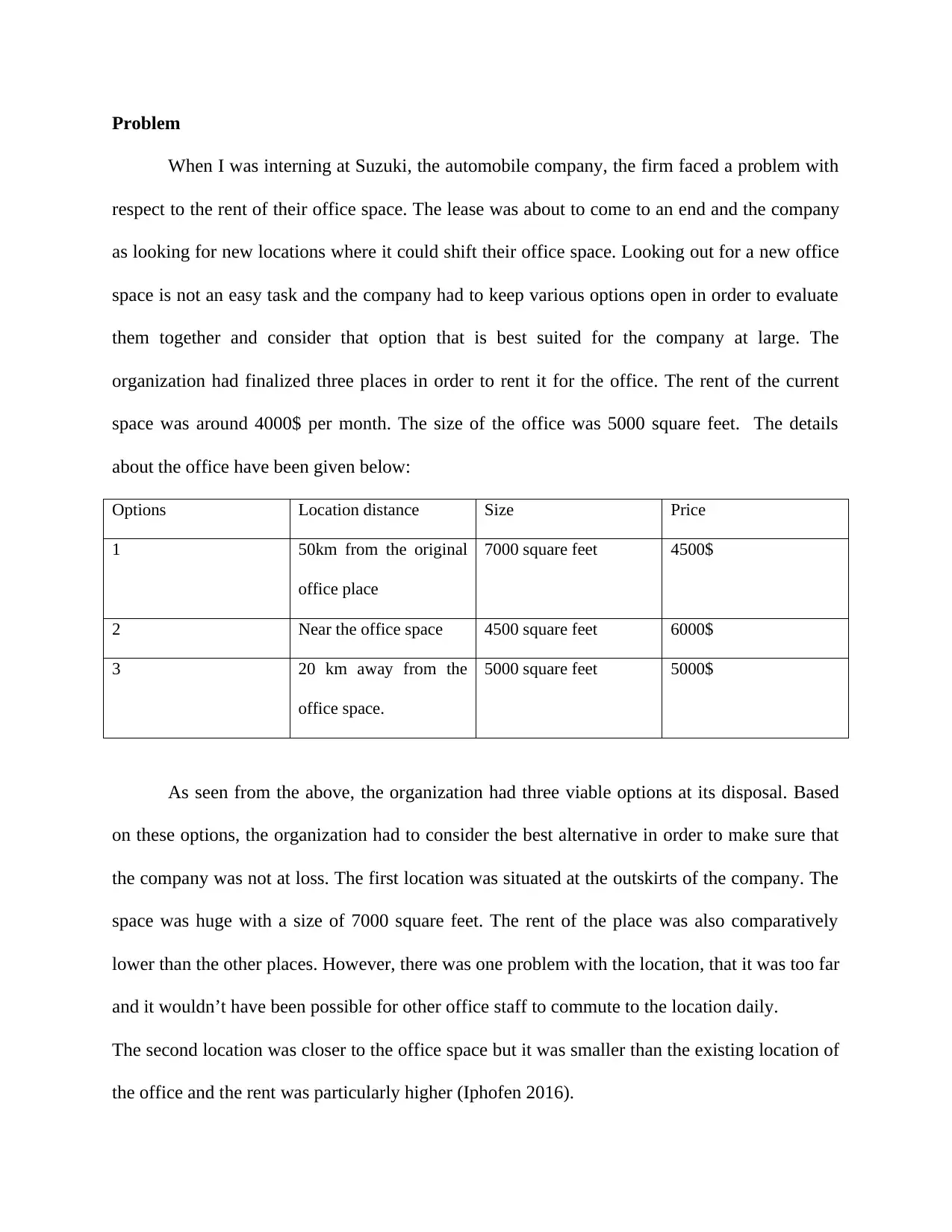
Problem
When I was interning at Suzuki, the automobile company, the firm faced a problem with
respect to the rent of their office space. The lease was about to come to an end and the company
as looking for new locations where it could shift their office space. Looking out for a new office
space is not an easy task and the company had to keep various options open in order to evaluate
them together and consider that option that is best suited for the company at large. The
organization had finalized three places in order to rent it for the office. The rent of the current
space was around 4000$ per month. The size of the office was 5000 square feet. The details
about the office have been given below:
Options Location distance Size Price
1 50km from the original
office place
7000 square feet 4500$
2 Near the office space 4500 square feet 6000$
3 20 km away from the
office space.
5000 square feet 5000$
As seen from the above, the organization had three viable options at its disposal. Based
on these options, the organization had to consider the best alternative in order to make sure that
the company was not at loss. The first location was situated at the outskirts of the company. The
space was huge with a size of 7000 square feet. The rent of the place was also comparatively
lower than the other places. However, there was one problem with the location, that it was too far
and it wouldn’t have been possible for other office staff to commute to the location daily.
The second location was closer to the office space but it was smaller than the existing location of
the office and the rent was particularly higher (Iphofen 2016).
When I was interning at Suzuki, the automobile company, the firm faced a problem with
respect to the rent of their office space. The lease was about to come to an end and the company
as looking for new locations where it could shift their office space. Looking out for a new office
space is not an easy task and the company had to keep various options open in order to evaluate
them together and consider that option that is best suited for the company at large. The
organization had finalized three places in order to rent it for the office. The rent of the current
space was around 4000$ per month. The size of the office was 5000 square feet. The details
about the office have been given below:
Options Location distance Size Price
1 50km from the original
office place
7000 square feet 4500$
2 Near the office space 4500 square feet 6000$
3 20 km away from the
office space.
5000 square feet 5000$
As seen from the above, the organization had three viable options at its disposal. Based
on these options, the organization had to consider the best alternative in order to make sure that
the company was not at loss. The first location was situated at the outskirts of the company. The
space was huge with a size of 7000 square feet. The rent of the place was also comparatively
lower than the other places. However, there was one problem with the location, that it was too far
and it wouldn’t have been possible for other office staff to commute to the location daily.
The second location was closer to the office space but it was smaller than the existing location of
the office and the rent was particularly higher (Iphofen 2016).
⊘ This is a preview!⊘
Do you want full access?
Subscribe today to unlock all pages.

Trusted by 1+ million students worldwide
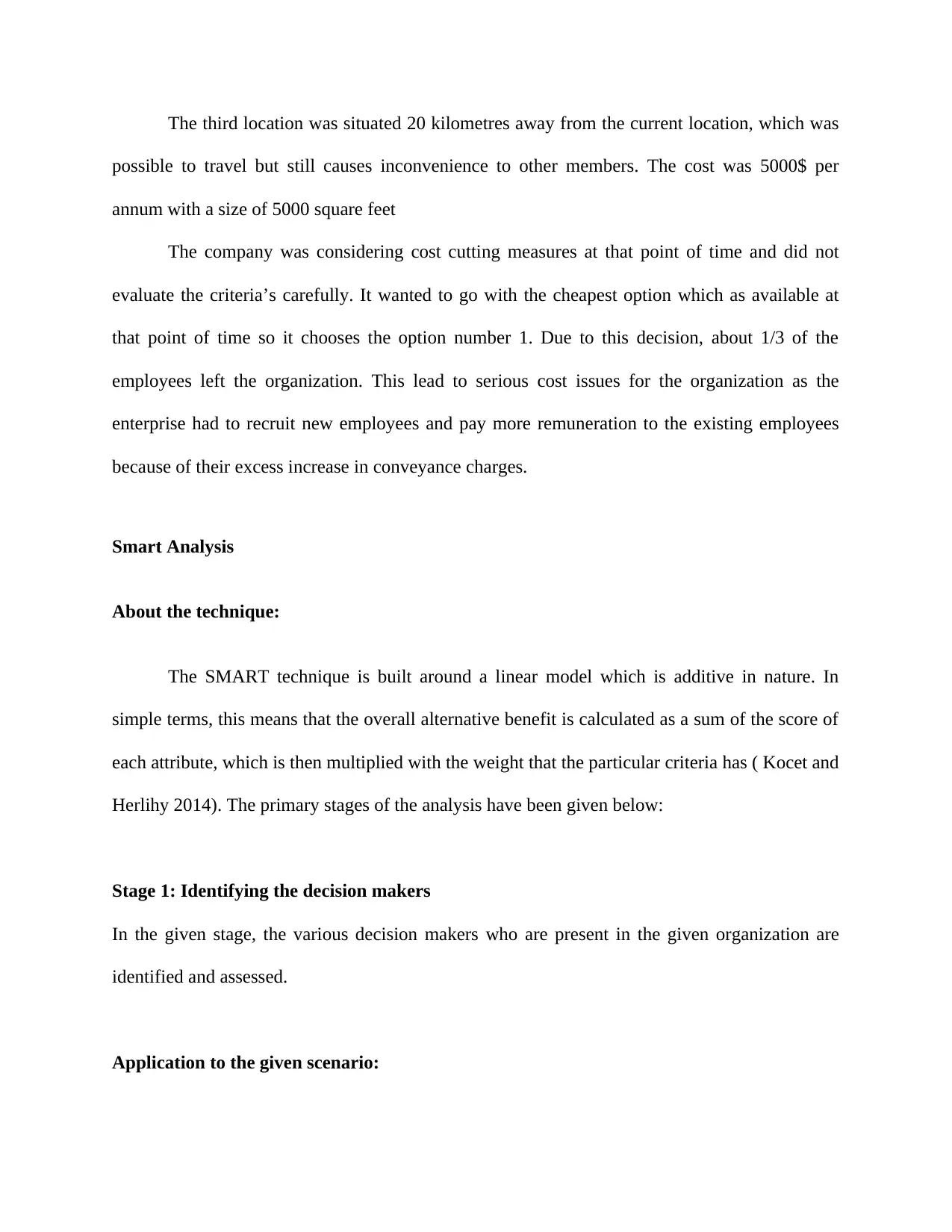
The third location was situated 20 kilometres away from the current location, which was
possible to travel but still causes inconvenience to other members. The cost was 5000$ per
annum with a size of 5000 square feet
The company was considering cost cutting measures at that point of time and did not
evaluate the criteria’s carefully. It wanted to go with the cheapest option which as available at
that point of time so it chooses the option number 1. Due to this decision, about 1/3 of the
employees left the organization. This lead to serious cost issues for the organization as the
enterprise had to recruit new employees and pay more remuneration to the existing employees
because of their excess increase in conveyance charges.
Smart Analysis
About the technique:
The SMART technique is built around a linear model which is additive in nature. In
simple terms, this means that the overall alternative benefit is calculated as a sum of the score of
each attribute, which is then multiplied with the weight that the particular criteria has ( Kocet and
Herlihy 2014). The primary stages of the analysis have been given below:
Stage 1: Identifying the decision makers
In the given stage, the various decision makers who are present in the given organization are
identified and assessed.
Application to the given scenario:
possible to travel but still causes inconvenience to other members. The cost was 5000$ per
annum with a size of 5000 square feet
The company was considering cost cutting measures at that point of time and did not
evaluate the criteria’s carefully. It wanted to go with the cheapest option which as available at
that point of time so it chooses the option number 1. Due to this decision, about 1/3 of the
employees left the organization. This lead to serious cost issues for the organization as the
enterprise had to recruit new employees and pay more remuneration to the existing employees
because of their excess increase in conveyance charges.
Smart Analysis
About the technique:
The SMART technique is built around a linear model which is additive in nature. In
simple terms, this means that the overall alternative benefit is calculated as a sum of the score of
each attribute, which is then multiplied with the weight that the particular criteria has ( Kocet and
Herlihy 2014). The primary stages of the analysis have been given below:
Stage 1: Identifying the decision makers
In the given stage, the various decision makers who are present in the given organization are
identified and assessed.
Application to the given scenario:
Paraphrase This Document
Need a fresh take? Get an instant paraphrase of this document with our AI Paraphraser
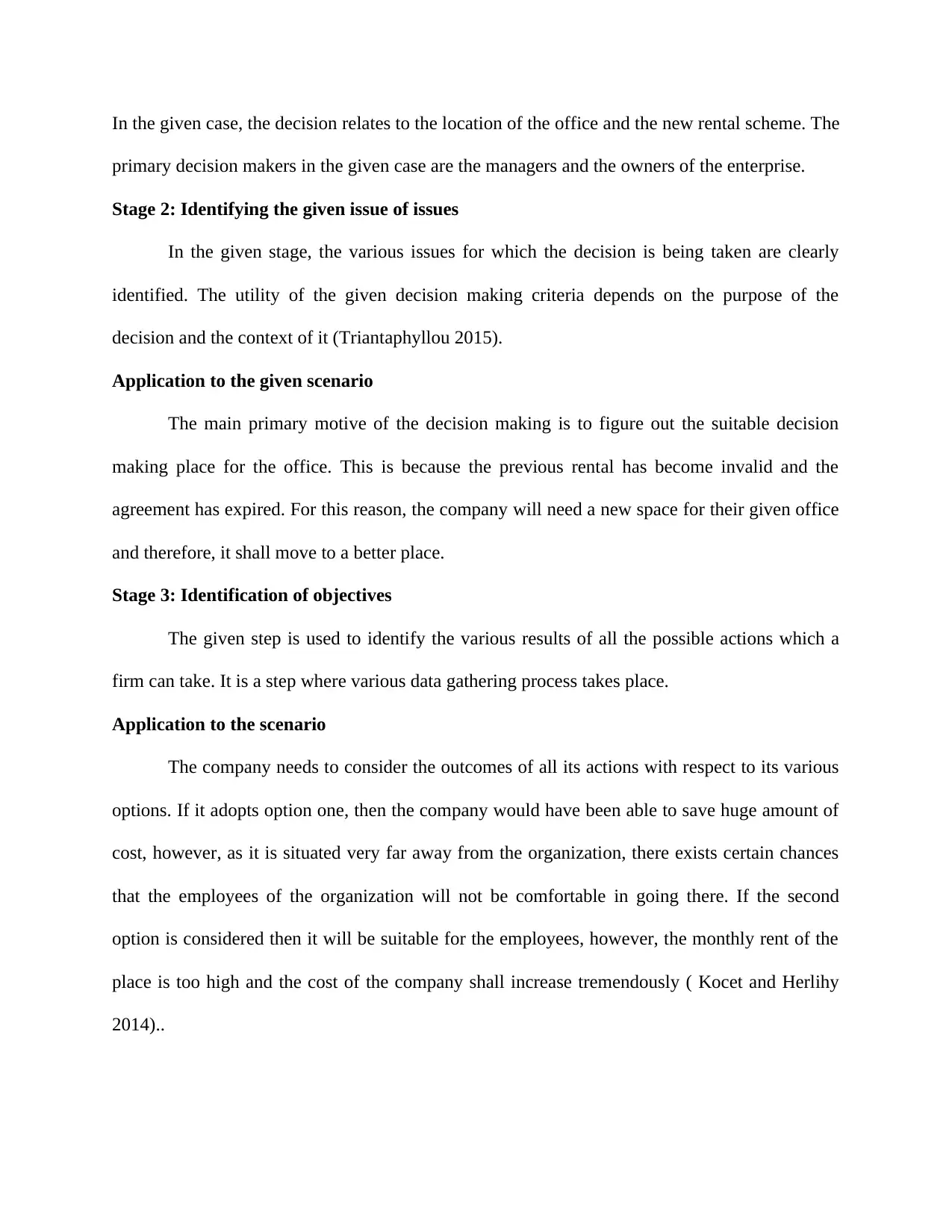
In the given case, the decision relates to the location of the office and the new rental scheme. The
primary decision makers in the given case are the managers and the owners of the enterprise.
Stage 2: Identifying the given issue of issues
In the given stage, the various issues for which the decision is being taken are clearly
identified. The utility of the given decision making criteria depends on the purpose of the
decision and the context of it (Triantaphyllou 2015).
Application to the given scenario
The main primary motive of the decision making is to figure out the suitable decision
making place for the office. This is because the previous rental has become invalid and the
agreement has expired. For this reason, the company will need a new space for their given office
and therefore, it shall move to a better place.
Stage 3: Identification of objectives
The given step is used to identify the various results of all the possible actions which a
firm can take. It is a step where various data gathering process takes place.
Application to the scenario
The company needs to consider the outcomes of all its actions with respect to its various
options. If it adopts option one, then the company would have been able to save huge amount of
cost, however, as it is situated very far away from the organization, there exists certain chances
that the employees of the organization will not be comfortable in going there. If the second
option is considered then it will be suitable for the employees, however, the monthly rent of the
place is too high and the cost of the company shall increase tremendously ( Kocet and Herlihy
2014)..
primary decision makers in the given case are the managers and the owners of the enterprise.
Stage 2: Identifying the given issue of issues
In the given stage, the various issues for which the decision is being taken are clearly
identified. The utility of the given decision making criteria depends on the purpose of the
decision and the context of it (Triantaphyllou 2015).
Application to the given scenario
The main primary motive of the decision making is to figure out the suitable decision
making place for the office. This is because the previous rental has become invalid and the
agreement has expired. For this reason, the company will need a new space for their given office
and therefore, it shall move to a better place.
Stage 3: Identification of objectives
The given step is used to identify the various results of all the possible actions which a
firm can take. It is a step where various data gathering process takes place.
Application to the scenario
The company needs to consider the outcomes of all its actions with respect to its various
options. If it adopts option one, then the company would have been able to save huge amount of
cost, however, as it is situated very far away from the organization, there exists certain chances
that the employees of the organization will not be comfortable in going there. If the second
option is considered then it will be suitable for the employees, however, the monthly rent of the
place is too high and the cost of the company shall increase tremendously ( Kocet and Herlihy
2014)..
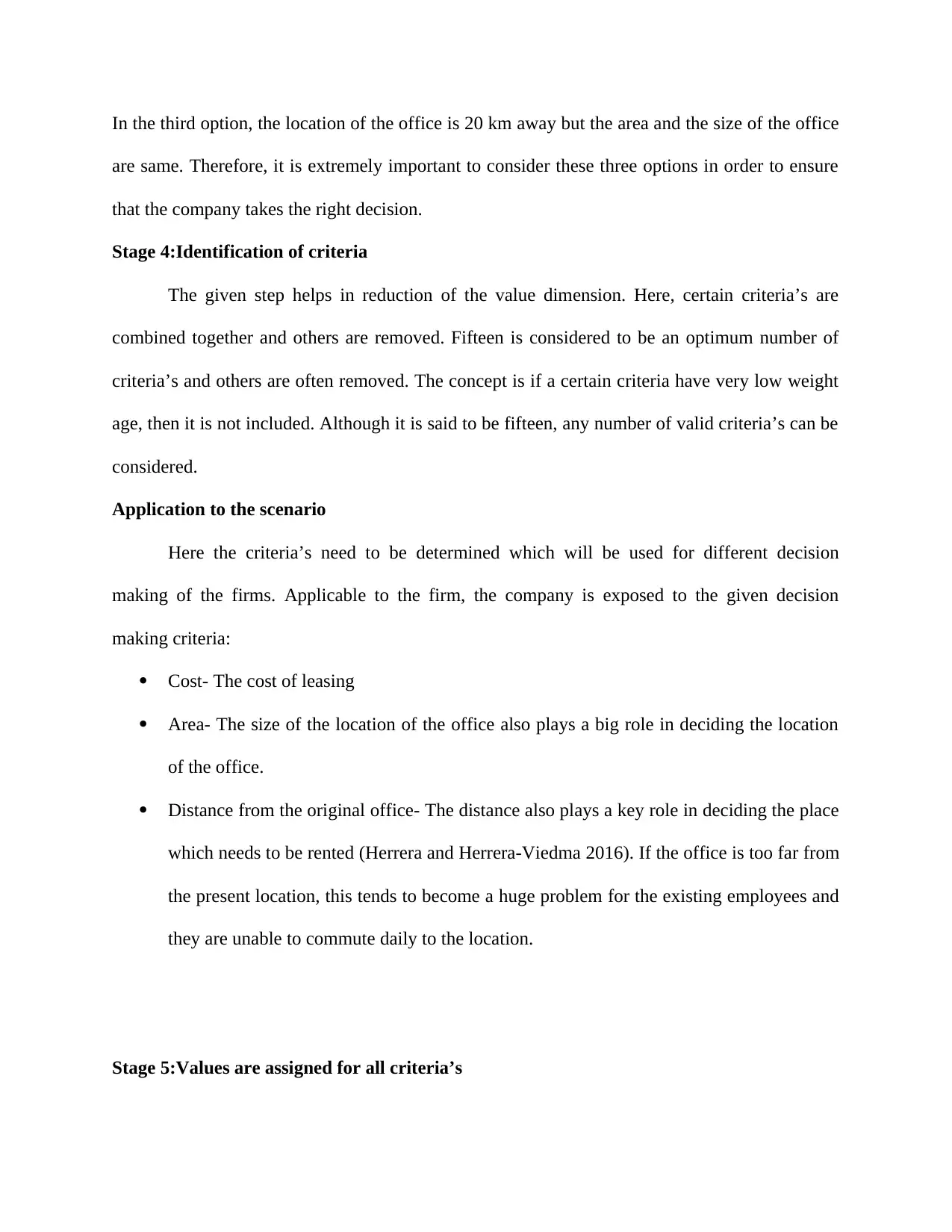
In the third option, the location of the office is 20 km away but the area and the size of the office
are same. Therefore, it is extremely important to consider these three options in order to ensure
that the company takes the right decision.
Stage 4:Identification of criteria
The given step helps in reduction of the value dimension. Here, certain criteria’s are
combined together and others are removed. Fifteen is considered to be an optimum number of
criteria’s and others are often removed. The concept is if a certain criteria have very low weight
age, then it is not included. Although it is said to be fifteen, any number of valid criteria’s can be
considered.
Application to the scenario
Here the criteria’s need to be determined which will be used for different decision
making of the firms. Applicable to the firm, the company is exposed to the given decision
making criteria:
Cost- The cost of leasing
Area- The size of the location of the office also plays a big role in deciding the location
of the office.
Distance from the original office- The distance also plays a key role in deciding the place
which needs to be rented (Herrera and Herrera-Viedma 2016). If the office is too far from
the present location, this tends to become a huge problem for the existing employees and
they are unable to commute daily to the location.
Stage 5:Values are assigned for all criteria’s
are same. Therefore, it is extremely important to consider these three options in order to ensure
that the company takes the right decision.
Stage 4:Identification of criteria
The given step helps in reduction of the value dimension. Here, certain criteria’s are
combined together and others are removed. Fifteen is considered to be an optimum number of
criteria’s and others are often removed. The concept is if a certain criteria have very low weight
age, then it is not included. Although it is said to be fifteen, any number of valid criteria’s can be
considered.
Application to the scenario
Here the criteria’s need to be determined which will be used for different decision
making of the firms. Applicable to the firm, the company is exposed to the given decision
making criteria:
Cost- The cost of leasing
Area- The size of the location of the office also plays a big role in deciding the location
of the office.
Distance from the original office- The distance also plays a key role in deciding the place
which needs to be rented (Herrera and Herrera-Viedma 2016). If the office is too far from
the present location, this tends to become a huge problem for the existing employees and
they are unable to commute daily to the location.
Stage 5:Values are assigned for all criteria’s
⊘ This is a preview!⊘
Do you want full access?
Subscribe today to unlock all pages.

Trusted by 1+ million students worldwide
1 out of 22
Related Documents
Your All-in-One AI-Powered Toolkit for Academic Success.
+13062052269
info@desklib.com
Available 24*7 on WhatsApp / Email
![[object Object]](/_next/static/media/star-bottom.7253800d.svg)
Unlock your academic potential
Copyright © 2020–2025 A2Z Services. All Rights Reserved. Developed and managed by ZUCOL.





